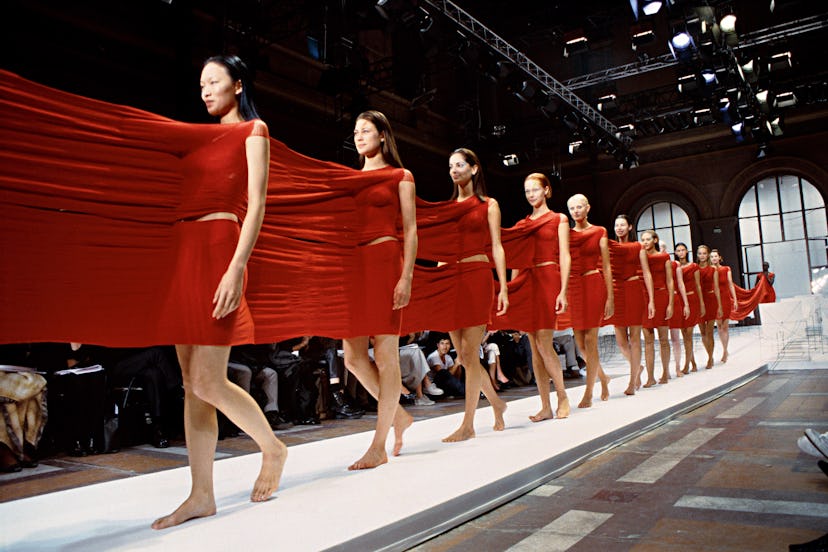Strength in Numbers: A Brief History of Fashion’s Fascination With Uniformity, Pre-Yeezy
Raf Simons, Hussein Chalayan, Rei Kawakubo, and more designers who found power in repetition.

At Yeezy Season 4 last week, scores of identically dressed models baked (and fainted) in the hot sun on Roosevelt Island for the sake of fashion, though they weren’t even wearing pieces from the new collection. That honor went to the bigger names who later emerged on the surrounding catwalk and snaked around the sweating, stationary masses. Though designer Kanye West had engineered a careful casting process for his centerpiece arrangement of mixed-race models, it soon become clear that their visual impact would be made en masse.
It was an expression of the power of uniformity that West has been wielding since 2014, when he first enlisted the artist Vanessa Beecroft for his Adidas shows. It’s a visual concept the two have now arguably — and with varying degrees of success — beaten to death on the turf on Roosevelt Island, though they were not the first to stake out the territory.
In fact, designers have been taking advantage of this method of presentation for years. In Runway: The Spectacle of Fashion, a forthcoming book that covers the most memorable fashion shows of the past 20 years, author and W‘s Features Director Alix Browne has included many instances of designers from the 90’s who paved the way for West.
Take, for example, Comme des Garçons spring 1996: Rei Kawakubo recruited dozens of supermodels for the show — though you wouldn’t even know it. She obscured their faces with cotton candy-colored wigs, and they meandered in circles, creating the effect of a swirling kaleidoscope. The effect was only amplified by the fashion onlookers clad in all black in the background.
Pre-Yeezy, Uniformity’s Biggest Hits on the Runway
Thom Browne fall 2009.
Hussein Chalayan spring 1998.
John Bartlett fall 2001.
Raf Simons fall 1998.
Comme des Garçons spring 2011 at Paris Fashion Week.
Thom Browne men’s spring 2014.
Rick Owens spring 2014 at Paris Fashion Week.
Issey Miyake spring 1999.
Comme des Garçons spring 1996.
Hussein Chalayan obscured his models’ faces in the ‘90s, too, although for a different reason: his Spring 1998 show explored clothing as a means of identity and expression through the lens of the burqa and the chador. A succession of models all wore the garb, though each was shrouded to varying degrees, the garments cut away incrementally until the last model’s revealed she had nothing on underneath.
At the time, fashion shows were still ephemeral, minimally documented performances for a handful of buyers and editors. Now that every image and movement is instantly and widely disseminated, Browne isn’t sure such an intimate exploration of identity as Chalayan’s could take place. Because of the platform of the internet, politicized runway shows nowadays tend to use their audience to push a message, or make a statement — see Opening Ceremony’s election-focused “Pageant of the People,” Rufus Wainwright’s outcry at Michael Kors, and Black Lives Matters activist DeRay McKesson’s support of Pyer Moss’s capitalism takedown, all just this recent NYFW. But for Spring 1998, Chalayan, who grew up in Turkish Cypriot when the country was torn by Christian-Muslim conflict, was using nudity not for shock value or as a statement but to question how fashion can erase and also express identity, with a few dozen witnesses. The runway was as personal a space for him as it was public, which seems impossible today.
But of course, the image still packs a punch. In fact, it fits right in with those of today’s designers, who are more than conscious of how their collections will enter the mainstream. Take Thom Browne‘s fall 2009 men’s show at Pitti Uomo, where 40-plus suited men made for office drones in matching suits and coats, and even desks and typewriters. It shares almost an identical set-up and color palette as West’s Yeezy Season 1.
And while West’s most recent show may have been less successful than previous outings, the concept marches on: A whole new wave of designers is already picking up the torch.